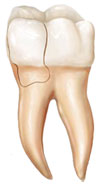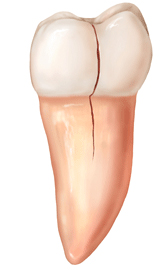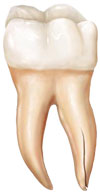How to deal with a cracked tooth
Cracked teeth demonstrate many types of symptoms, including pain when chewing, temperature sensitivities, or even the release of biting pressure. It is also common for pain to come and go, making it difficult to diagnose the cause of discomfort.
Chewing can cause movement of the cracked pieces of your tooth, and the pulp within the tooth becomes irritated. At the same time, when biting pressure is released, the crack can close quickly, resulting in sharp pain. Eventually, the pulp will become damaged and tooth will consistently hurt, even when you are not chewing. It is possible that cracks can lead to infection of the pulp tissue, which can spread to the bone and gum surrounding the problematic tooth.
Types of Cracks
Craze Lines
These are tiny cracks that only affect the outer enamel of the tooth. These cracks are more common in adults. These types of cracks are superficial and are usually of no concern.
 Fractured Cusp
Fractured Cusp
When a cusp becomes weakened, a fracture may result. The cusp may break off or be removed by a dentist. A fractured cusp rarely damages the pulp, so root canal is not necessary. Your dentist will usually restore the tooth with a full crown.
 Non-treatable Cracked Tooth
Non-treatable Cracked Tooth
In this case, the crack extends from the chewing surface toward the root in a vertical direction, and may extend below the gum line into the root damaging the pulp. Root canal therapy along with a proper restoration of the tooth is necessary. An untreated cracked tooth can become worse making it non-treatable, causing tooth loss.
 Split Tooth
Split Tooth
A split tooth is caused by a cracked tooth that has gone untreated over a period of time. The tooth is literally split into two pieces by a crack that runs through the tooth. A tooth can be split mesio-distally or linguo-buccally.
 Vertical Root Fracture
Vertical Root Fracture
This type of fracture begins at the root and extends toward the chewing surface. It is seen more often on teeth that have had previous root canal therapy. Since there are usually minimal symptoms with this type of crack, it can go unnoticed. If portion of the root can be saved, the treatment involves endodontic surgery. Otherwise, fractured tooth will have to be extracted.